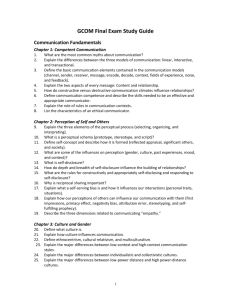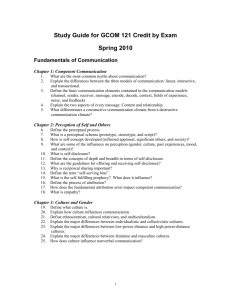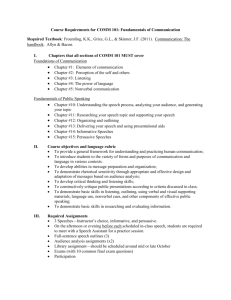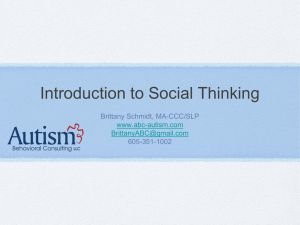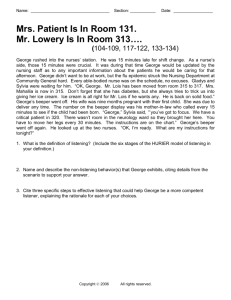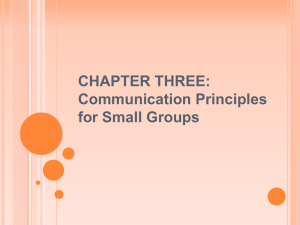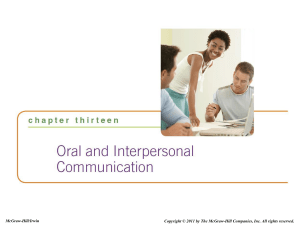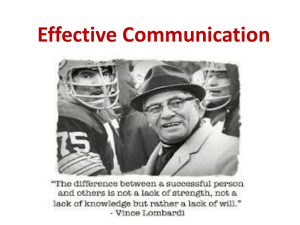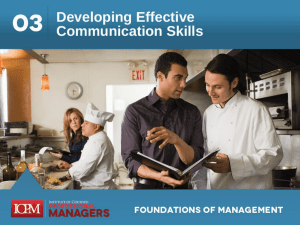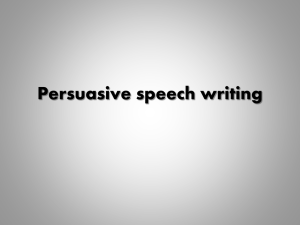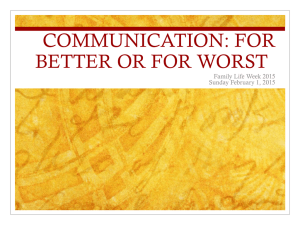GCOM Final Exam Study Guide
advertisement
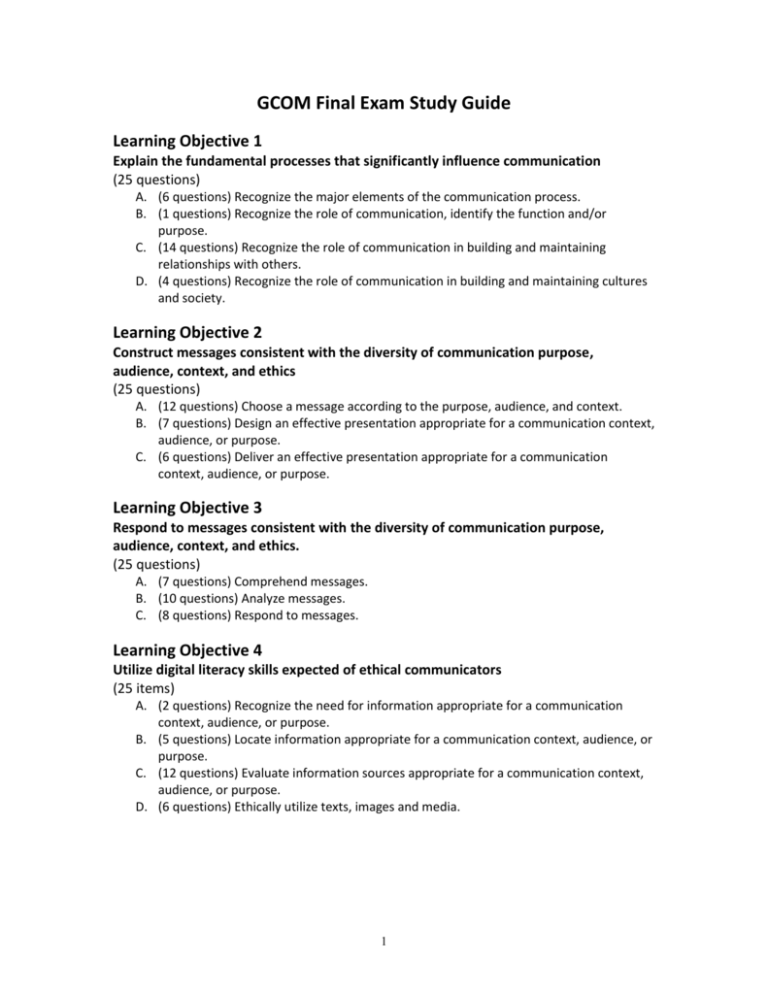
GCOM Final Exam Study Guide Learning Objective 1 Explain the fundamental processes that significantly influence communication (25 questions) A. (6 questions) Recognize the major elements of the communication process. B. (1 questions) Recognize the role of communication, identify the function and/or purpose. C. (14 questions) Recognize the role of communication in building and maintaining relationships with others. D. (4 questions) Recognize the role of communication in building and maintaining cultures and society. Learning Objective 2 Construct messages consistent with the diversity of communication purpose, audience, context, and ethics (25 questions) A. (12 questions) Choose a message according to the purpose, audience, and context. B. (7 questions) Design an effective presentation appropriate for a communication context, audience, or purpose. C. (6 questions) Deliver an effective presentation appropriate for a communication context, audience, or purpose. Learning Objective 3 Respond to messages consistent with the diversity of communication purpose, audience, context, and ethics. (25 questions) A. (7 questions) Comprehend messages. B. (10 questions) Analyze messages. C. (8 questions) Respond to messages. Learning Objective 4 Utilize digital literacy skills expected of ethical communicators (25 items) A. (2 questions) Recognize the need for information appropriate for a communication context, audience, or purpose. B. (5 questions) Locate information appropriate for a communication context, audience, or purpose. C. (12 questions) Evaluate information sources appropriate for a communication context, audience, or purpose. D. (6 questions) Ethically utilize texts, images and media. 1 Communication Fundamentals Chapter 1: Competent Communication 1. 2. 3. 4. 5. 6. 7. 8. What are the most common myths about communication? Explain the differences between the three models of communication: linear, interactive, and transactional. Define the basic communication elements contained in the communication models (channel, sender, receiver, message, encode, decode, context, fields of experience, noise, and feedback). Explain the two aspects of every message: Content and relationship. How do constructive versus destructive communication climates influence relationships? Define communication competence and describe the skills needed to be an effective and appropriate communicator. Explain the role of rules in communication contexts. List the characteristics of an ethical communicator. Chapter 2: Perception of Self and Others 9. 10. 11. 12. 13. 14. 15. 16. 17. 18. 19. Explain the three elements of the perceptual process (selecting, organizing, and interpreting). What is a perceptual schema (prototype, stereotype, and script)? Define self-concept and describe how it is formed (reflected appraisal, significant others, and society). What are some of the influences on perception (gender, culture, past experiences, mood, and context)? What is self-disclosure? How do depth and breadth of self-disclosure influence the building of relationships? What are the rules for constructively and appropriately self-disclosing and responding to self-disclosure? Why is reciprocal sharing important? Explain what a self-serving bias is and how it influences our interactions (personal traits, situations). Explain how our perceptions of others can influence our communication with them (first impressions, primacy effect, negativity bias, attribution error, stereotyping, and selffulfilling prophecy). Describe the three dimensions related to communicating “empathy.” Chapter 3: Culture and Gender 20. 21. 22. 23. 24. 25. 26. 27. Define what culture is. Explain how culture influences communication. Define ethnocentrism, cultural relativism, and multiculturalism. Explain the major differences between low-context and high-context communication styles. Explain the major differences between individualistic and collectivistic cultures. Explain the major differences between low-power distance and high power-distance cultures. Explain the major differences between feminine and masculine cultures. How does culture influence nonverbal communication? 2 Chapter 4: Language 28. 29. 30. 31. 32. 33. Explain the four elements common to all languages (structure, productivity, displacement, and self-reflexiveness). Explain the abstracting process (sense experience, description, inference, and judgment). Explain the two versions of the Sapir-Whorf hypothesis and their relationship to culture. Explain how connotative meaning differs from denotative meaning. What is the difference between a fact and an inference? How might the use of slang, jargon, and euphemisms influence the understanding of a communication message? Chapter 5: Nonverbal Communication 34. 35. 36. Explain how nonverbal channels of communication differ from verbal channels. Explain how nonverbal communication functions in relationship with verbal communication (repetition, substitution, regulation, contradiction, accentuation). Explain the major types of nonverbal communication (kinesics, paralanguage, territoriality, proxemics, and haptics). Chapter 6: Listening to Others 37. 38. 39. 40. 41. Define listening by its basic elements (comprehending, retaining, and responding). Define the three types of listening (informational, critical and empathic). Explain the problems that can interfere with competent informational listening (conversational narcissism, competitive interrupting, glazing over, pseudo-listening, and ambushing). Explain the problems that can interfere with competent critical listening (skepticism, true belief, and cynicism). Describe the listening response styles associated with empathic listening and nonempathic listening. Public Speaking Chapter 12: Preparing Speeches 42. 43. 44. 45. 46. 47. 48. 49. 50. What are the components of doing an audience analysis, and how is a speech adapted based on those components (demographics, values, beliefs, & attitudes)? How are the preparation and presentation of a speech influenced by audience analysis? Define the general purpose, specific purpose, and central idea in public speaking. What should be considered when choosing a topic (speaker, subject, occasion, and audience)? How does one avoid plagiarism? What are the main types of supporting materials used in speeches? What are the criteria for evaluating supporting material? What are the components of a competent presentation body? Identify the organizational pattern used in speeches (topical, spatial, causal, chronological, problem-solution, and Monroe’s Motivated Sequence). 3 Chapter 13: Presenting Speeches 51. 52. 53. 54. 55. 56. 57. What are some guidelines for managing speech anxiety? What are the critical elements of a competent speech introduction? How does a speaker create credibility and identification in an introduction? What are the critical elements of a competent speech conclusion? How does the oral style of communication differ from a written style? What impact do various delivery considerations have on an audience (eye contact, vocal variety, verbal fluency, poise, dynamism)? Explain the differences between the major delivery styles (manuscript, memorized, extemporaneous, and impromptu). Chapter 14: Informative Speaking 58. 59. 60. 61. 62. What distinguishes informative speaking from persuasive speaking? What are signposts and transitions, and how are they used in constructing a presentation? Describe the characteristics of an appropriate or effective oral citation. What are the types of visual aids that can be used during a speech? What are guidelines for the competent usage of visual aids? Chapter 15: Persuasive Speaking 63. 64. 65. 66. Define persuasion. What are the primary dimensions of credibility (competence trustworthiness, dynamism, and composure)? Identify and discuss how the three Aristotelian modes of proof (ethos, logos, and pathos) are used in persuasive speeches. Identify and discuss how propositions of fact, value, and policy are used in persuasive speeches. 4
